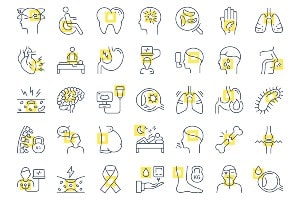About Bartonella henselae Infection (Cat Scratch Disease)

Learn about the disease, illness and/or condition Bartonella henselae Infection (Cat Scratch Disease) including: symptoms, causes, treatments, contraindications and conditions at ClusterMed.info.
Bartonella henselae Infection (Cat Scratch Disease)

| Bartonella henselae Infection (Cat Scratch Disease) |
|---|
Bartonella henselae Infection (Cat Scratch Disease) InformationAvailable tests and treatmentsPeopleTalk to your doctor about testing and treatments for CSD. People are only tested for CSD when the disease is severe and the doctor suspects CSD based on the patient's symptoms. CSD is typically not treated in otherwise healthy people.CatsTalk to your veterinarian about testing and treatments for your cat. Your veterinarian can tell you whether your cat requires testing or treatment. Cat scratch disease facts**Cat scratch disease facts by John P. Cunha, DO, FACOEP
How cats and people become infectedCats can get infected with B. henselae from flea bites and flea dirt (droppings) getting into their wounds. By scratching and biting at the fleas, cats pick up the infected flea dirt under their nails and between their teeth. Cats can also become infected by fighting with other cats that are infected. The germ spreads to people when infected cats bite or scratch a person hard enough to break their skin. The germ can also spread when infected cats lick at wounds or scabs that you may have. More informationCat-Scratch Disease in Children - Texas, September 2000 - August 2001. Morbidity and Mortality Weekly Report. 2002 Mar;51(10):212-214.Unraveling Mysteries Associated with Cat-Scratch Disease, Bacillary Angiomatosis, and Related Syndromes. Emerging Infectious Diseases Journal. January-March 1995, Volume 1, Number 1:16-21.Epidemiologic Notes and Reports Encephalitis Associated with Cat Scratch Disease - Broward and Palm Beach Counties, Florida, 1994. Morbidity and Mortality Weekly Report. December 16, 1994 / 43(49);909,915-916.Mofenson LM, Brady MT, Danner SP, Dominguez KL, Hazra R, Handelsman E, et al. Guidelines for the prevention and treatment of opportunistic infections among HIV-exposed and HIV-infected children. Morbidity and Mortality Weekly Report. 2009 Sept;58(RR11):1-166. PreventionPeopleDo:
Serious but rare complicationsPeopleAlthough rare, CSD can cause people to have serious complications. CSD can affect the brain, eyes, heart, or other internal organs. These rare complications, which may require intensive treatment, are more likely to occur in children younger than 5 years and people with weakened immune systems.CatsMost cats with B. henselae infection show NO signs of illness, but on rare occasions this disease can cause inflammation of the heart -- making cats very sick with labored breathing. B. henselae infection may also develop in the mouth, urinary system, or eyes. Your veterinarian may find that some of your cat's other organs may be inflamed. What is cat scratch disease?Cat-scratch disease (CSD) is a bacterial infection spread by cats. The disease spreads when an infected cat licks a person's open wound, or bites or scratches a person hard enough to break the surface of the skin. About three to 14 days after the skin is broken, a mild infection can occur at the site of the scratch or bite. The infected area may appear swollen and red with round, raised lesions and can have pus. The infection can feel warm or painful. A person with CSD may also have a fever, headache, poor appetite, and exhaustion. Later, the person's lymph nodes closest to the original scratch or bite can become swollen, tender, or painful.Wash cat bites and scratches well with soap and running water. Do not allow cats to lick your wounds. Contact your doctor if you develop any symptoms of cat-scratch disease or infection.CSD is caused by a bacterium called Bartonella henselae. About 40% of cats carry B. henselae at some time in their lives, although most cats with this infection show NO signs of illness. Kittens younger than 1 year are more likely to have B. henselae infection and to spread the germ to people. Kittens are also more likely to scratch and bite while they play and learn how to attack prey. |
More Diseases
A | B | C | D | E | F | G | H | I | J | K | L | M | N | O | P | Q | R | S | T | U | V | W | X | Y | Z
Diseases & Illnesses Definitions Of The Day
- Noncancerous Colloid Thyroid Nodule (Thyroid Nodules) ‐ How are thyroid nodules diagnosed?, Introduction to thyroid nodules …
- Skin, Laser Resurfacing (Laser Resurfacing) ‐ CO2 Laser Resurfacing, Complications of Laser Skin Resurfacing …
- Malignant Fibrous Histiocytoma (Bone Cancer Overview) ‐ Are there any treatments or medications that relieve bone cancer pain? …
- Double Vision ‐ Is it possible to prevent double vision?, What are the symptoms and signs of double vision? …
- Ageusia (Taste Disorders) ‐ Are taste disorders serious?, Can taste disorders be treated? …
- Autism Screening and Diagnosis ‐
- Alpha-fetoprotein Blood Test ‐ In which situations are high blood (serum) levels of AFP used as a tumor marker? …
- Polymyalgia Rheumatica ‐ How do health care professionals make a diagnosis of polymyalgia rheumatica? …
- Stump Appendicitis (Appendicitis) ‐ Appendicitis definition and facts, Are there long-term consequences of appendectomy? …
- Gonorrhea (Gonorrhea In Women) ‐ Gonorrhea facts, How is gonorrhea diagnosed?, What are sexually transmitted diseases (STDs)? …